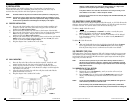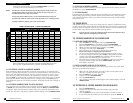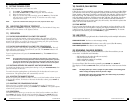
2
3
3
4
5
5
5
5
6
6
6
9
9
9
10
10
10
11
11
11
12
12
13
13
14
14
14
15
15
15
16
16
17
3) In certain circumstances, it may be necessary for the telephone company to request information from
you concerning the equipment which you have connected to your telephone line. Upon request of the tele-
phone company, provide the FCC registration number and the ringer equivalence number of the equipment
which is connected to your line. This information will be found on the bottom of your telephone.
4) If any of your telephone equipment is not operating properly, you should immediately remove it from the
telephone line. It may cause harm to the telephone network.
5) If the telephone company notes a problem, they may temporarily discontinue service. When practical,
they will notify you in advance of disconnection. If advance notice is not feasible, the telephone company
must: Promptly notify you of such temporary discontinuance; Afford the opportunity to correct the condition;
Inform you of your rights to bring a complaint to the FCC under their rules.
6) Repairs to the device may be made only by the manufacturer or an authorized service agency. This
applies at any time during and after warranty. If unauthorized repair is performed, registration, connection
to the telephone lines and remainder of warranty period all become null and void.
7) This equipment is hearing aid compatible.
8) This telephone must be connected behind a PBX.
31) REQUIREMENTS OF PART 15- FCC RULES
NOTE: This equipment has been tested and found to comply with the limits for a Class B digital device,
pursuant to Part 15 of the FCC Rules. These limits are designed to provide reasonable protection against
harmful interference in a residential installation. This equipment generates, uses, and can radiate radio fre-
quency energy and, if not installed and used in accordance with the instruction, may cause harmful inter-
ference to radio communications. However, there is not a guarantee that interference will not occur in a
particular installation. If this equipment does cause harmful interference to radio or television reception,
which can be determined by turning the equipment off and on, the user is encouraged to try to correct the
interference by one or more of the following measures: 1) Move the telephone away from the receiver. 2)
Consult the dealer or an experienced radio/TV technician for help. Any changes made by the user not
approved by the manufacturer can void the user’s authority to operate the telephone.
32) INDUSTRY OF CANADA REQUIREMENTS
NOTICE: The Industry Canada label identifies certified equipment. This certification means that the equip-
ment meets certain telecommunications network protective operational and safety requirements as pre-
scribed in the appropriate Terminal Equipment Technical Requirements documents. The department does
not guarantee the equipment will operate to the user satisfaction.
Before installing this equipment, users should ensure that it is permissible to be connected to the facilities
of the local telecommunications company. The equipment must also be installed using an acceptable
method of connection.
The customer should be aware that compliance with the above conditions may not prevent degradation of
service in some situations. Repairs to certified equipment should be coordinated by a representative desig-
nated by the supplier. Any repairs or alterations made by the user to this equipment, or equipment malfunc-
tions, may give the telecommunications company cause to request the user to disconnect the equipment.
Users should ensure for their own protection that the electrical ground connections of the power utility, tele-
phone lines, and internal metallic water pipe systems, if present, are connected together. This precaution
may be particularly important in rural areas.
CAUTION: Users should not attempt to make such connections themselves, but should contact the
appropriate electric inspection authority or electrician, as appropriate. The Ringer Equivalence Number
(REN) of this device is z.
TABLE OF CONTENTS
1) FEATURES
2) IMPORTANT CALLER ID INFORMATION
3) IMPORTANT NOTICE BEFORE INSTALLATION
4) INSTALLATION
4.1 DESKTOP INSTALLATION
4.2 WALL MOUNTING
5) USING THE DATA PORT
6) SETTING THE RING CADENCES
7) ADJUSTING THE RINGER VOLUME
8) SETTING THE DATE AND TIME
9) SETTING THE AREA CODE
10) ADJUSTING THE DISPLAY CONTRAST
11) OPERATION
11.1 PLACING AND ANSWERING CALLS WITH THE HANDSET
11.2 PLACING AND ANSWERING CALLS WITH THE SPEAKERPHONE
11.3 SWITCHING BETWEEN THE HANDSET AND THE SPEAKERPHONE
11.4 ADJUSTING THE HANDSET’S VOLUME
11.5 ADJUSTING THE SPEAKERPHONE VOLUME
11.6 USING REDIAL
11.7 USING LINK
11.8 USING HOLD
11.9 USING MUTE
11.10 MEMORY DIALING
11.11 STORING A NUMBER IN MEMORY
11.12 ENTERING A PAUSE IN A MEMORY NUMBER
11.13 STORING NUMBERS FROM CALLER ID RECORDS
11.14 DIALING A MEMORY NUMBER
11.15 CHAIN DIALING
12) PHONE BOOK
13) STORING NUMBERS IN THE PHONE BOOK
13.1 WITH NO NUMBER DISPLAYED
13.2 WITH A NUMBER ALREADY DISPLAYED
14) RETRIEVING A STORED NUMBER IN MEMORY / ON HOOK MODE
15) DELETING A NAME AND NUMBER IN THE DIRECTORY
16) CONNECTING AN OPTIONAL HEADSET
17) ADJUSTING HEADSET VOLUME
18) CALLER ID, CALL WAITING
19) LED STATUS
20) REVIEWING CALLER ID RECORDS
21) CALLER ID MESSAGES
22) USING THE DIAL KEY
23) DELETING CALLER ID RECORDS
24) PRIORITY (VIP) CALL
25) MESSAGE WAITING
26) TROUBLESHOOTING
27) CARE AND MAINTENANCE
28) WHAT THE FCC WANTS YOU TO KNOW
29) LIGHTNING
30) REQUIREMENTS OF PART 68 – FCC RULES
31) REQUIREMENTS OF PART 15 – FCC RULES
32) INDUSTRY OF CANADA REQUIREMENTS
33) IMPORTANT SAFETY INSTRUCTIONS
16
Teledex B150D Users Manual
REQUIREMENTS
P/N 600-0480-52


















